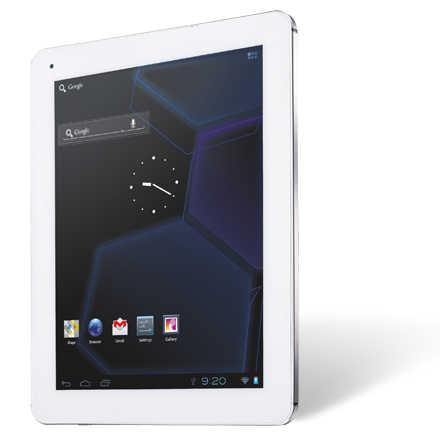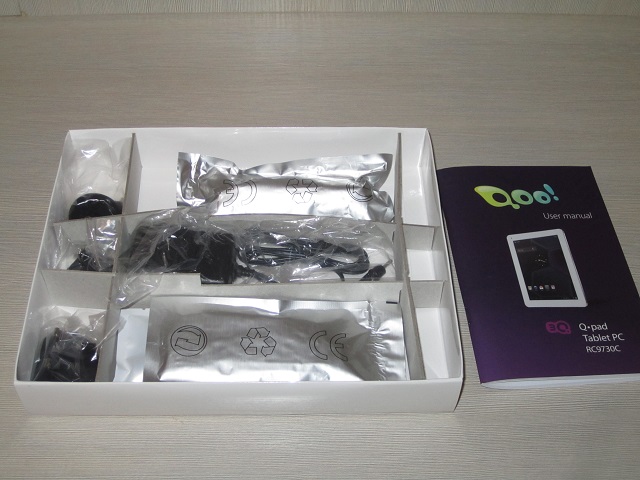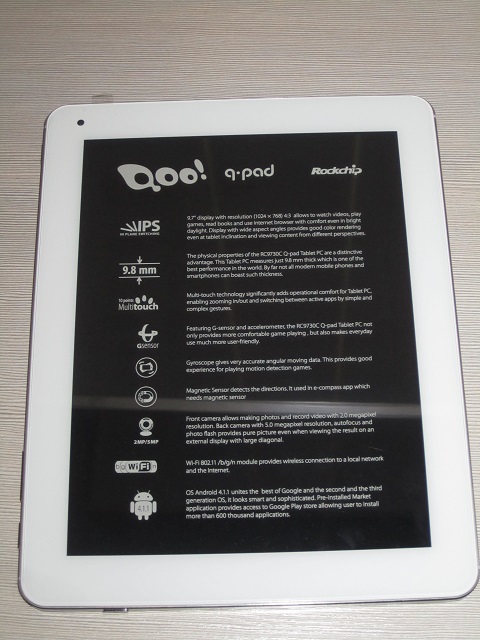Month with 3Q RC9730C tablet
 My acquaintance with the 3Q company began outside the box. I decided to buy for travel light compact laptop with a diagonal of 11.6. The key parameters were chosen diagonal and weight at an affordable price. Then I learned that there is a company 3Q, which developed the ES1105N netbook, which is quite interesting for my requests. The device deserves a separate article, but in the meantime the story continues. I did not have time to leave with a new beech on vacation, as he stopped working. Just disappeared SSD from the system. What to do, I wrote to tech support, took the old laptop and drove off to Kiev for the holidays. There was a thought that he did not spare 300 rubles for the service of quick replacement of marriage in the store.
My acquaintance with the 3Q company began outside the box. I decided to buy for travel light compact laptop with a diagonal of 11.6. The key parameters were chosen diagonal and weight at an affordable price. Then I learned that there is a company 3Q, which developed the ES1105N netbook, which is quite interesting for my requests. The device deserves a separate article, but in the meantime the story continues. I did not have time to leave with a new beech on vacation, as he stopped working. Just disappeared SSD from the system. What to do, I wrote to tech support, took the old laptop and drove off to Kiev for the holidays. There was a thought that he did not spare 300 rubles for the service of quick replacement of marriage in the store.Upon return, I found out that the tech support responded literally an hour later, offering to hand over the laptop to the service. But there was no point, I went to change. To my disappointment, there was no such device for exchange in the warehouse, after a long selection from the store catalog another brand took it. Nevertheless, ES1105N managed to catch something and did not get out of my head. After some time I came across a 3Q group in Vkontakte and wrote my own story to them. A dialogue ensued, the result of which was my suggestion to write a review of one of the company's tablets. Yes, yes, this article is the real order! Joke :) The condition was an impartial and honest study of the tablet with all its pluses and minuses in exchange for the device itself.
So, a 9.7 inch RC9730C tablet fell into my hands. After a month of active use, we managed to identify its strengths and weaknesses and form a complete opinion about this device.
Specifications
| operating system | Google Android 4.1.1 (Jelly Bean) |
| Processor / platform | Rockchip 3066 dual-core, ARM Cortex-A9, 2 cores, 1.6 GHz |
| Screen | 9.7 "(1024 x 768) IPS, multi-touch up to 10 touch points |
| RAM | DDR3 1 GB |
| Storage device | eMMC 8 GB |
| Wi-Fi | 802.11b / g / n |
| Bluetooth | 2.1 + EDR, 3.0 |
| Camera | Frontal - 2.0 megapixel, rear - 5.0 megapixel with autofocus mechanism |
| Accelerometer (G-sensor) | Yes, three-axle |
| Gyrosensor (position sensor) | there is |
| Magnetic sensor | there is |
| Battery | Lithium-polymer battery, power consumption of 22.1 W • h (6000 mA • h @ 3.7 V) |
| Data Interfaces (Ports) | Micro USB 2.0 host, microSD memory card slot, headphone jack (3.5 mm jack) |
| Audio | Built-in stereo speakers, built-in microphone |
| Control | Volume control, power on / off, reboot, back key |
| Sizes, mm | 243 × 190 × 9.8 |
| Weight, g | 630 |
| Colour | White |
The average price at the time of this writing is about 7,000 rubles.
Packing and packaging

The device is packaged in a small rectangular box of thick white cardboard. Directly under the lid is a tablet, lined with soft inserts around the perimeter. Under the tablet is a large box with instructions in 36 languages, a micro USB cable, an OTG cable, standard headphones, and a charger. The charger is designed for a network of 100-240V and is equipped with three types of plugs: European, American and, apparently, British. It is unlikely that this diversity is due to concern for travelers. Rather, the reason for the unification of production for different markets.


The charger plug almost coincides with that of the old Nokia phones and outputs 5V at the output. If you remember, there was a “thick” charger for Nokia, then a “thin” appeared. So here it is “thin”. Curiosity made me stick (with some effort) into the tablet the charger found at home from some Nokia. And you know what - it charges! Despite the passport current 2A from the native charger and 350mA from the phone. Car also earned. I do not know how long it will charge, but the result is already encouraging. Given the lack of a car charger for these tablets, it is hoped to “feed” the device on a long trip from an old phone charger, which you probably have if not in your car, or at a neighbor or in a communications salon, at worst.
True, now the logical question arises: if the device can charge from 5V / 350mA, why not make it possible to charge from USB, where is all 500mA? Let it be long, but it would be a killer feature, no doubt.
')
Visual inspection

The tablet is a traditional rounded rectangle in the corners with a white frame. The back is also white, as if varnished, with a large Qoo logo! centered (By the way, about the logo. Maybe I'm overly subjective, but these cartoon letters are badly associated with electronics). Along the perimeter, the device is edged with a metal frame like SGS4 or iPhone4. According to information from the manufacturer, this is not just an edging, but an outwardly protruding inner metal support frame of the device. Judging by the rigidity of the device for bending and twisting - the way it is. It is hoped that the frame will help the device to endure difficult operating conditions. The tablet is weighty and monolithic, something like a tile on the sensations :) The build quality. No backlash, squeaks or cracks are observed. In addition to the traditional film with text and pictograms, the screen is covered with a factory protective film, which is certainly a plus.
Interfaces, ergonomics
The first problem I encountered during operation is difficult to navigate, where the device has the top, and where the bottom. It is clear that the image is always rotated as expected, talking about the buttons and connectors, located, at first glance, somewhat chaotic. So, if you place the tablet in standard portrait orientation in accordance with the logo on the back cover, the connectors and controls will be located as follows:
1. Front camera in the upper left corner of the frame. Behind her is the main camera behind.
2. At the top, from left to right: microSD slot, charging connector, microUSB connector, 3.5 mm headphone jack.
3. On the left side, top to bottom: back button, volume rocker, menu button.
4. On the bottom left of the on / off button.
The right end remained empty.
The location of the elements becomes more logical in landscape orientation. However, it should be noted, the front camera is configured in such a way that it looks in your face in portrait orientation. All buttons, as well as the frame - metal, are pressed with a comfortable effort. The power button is occasionally pressed accidentally, although it does not rest on the palm.
Screen and sensor
The device is equipped with a 9.7-inch IPS-matrix with a resolution of 1024x768 pixels. The picture quality is excellent, the viewing angles on both axes are close to 180 degrees. According to information from the manufacturer, the matrix of the same model as on iPad2. The touch screen also does not cause any complaints, it works perfectly.
Performance and Stability
Now you will not surprise anyone with a 1.6 GHz dual-core processor and a gigabyte of RAM. You can say this is the basic level for a modern tablet. In the race of cores and gigabytes, the manufacturer chose a pragmatic position, obviously counting on the same pragmatic buyer. The configuration “behind the eyes” is enough for operating the OS and comfortable work with almost any applications. Except for possibly the coolest games. Software, as always, does not keep up with the hardware, the history of desktop computers repeats.
As for the stability of the work, for the month of active use nothing happened that could be called even the slightest failure. The tablet, justifying its durable and monolithic appearance, on the reliability of the internal filling and software was also on top.
power usage
The device is equipped with a battery capacity of 6000mAh. It is a lot or a little - it depends on the consumption of the device, and here it is worth putting the manufacturer a definite plus. Over energy consumption clearly worked well. The tablet is able to play video for 6-8 hours. Or work for a week an hour a day, almost without discharging in sleep mode. Decent performance to date. Much credit goes to the economical processor.
Cameras
Front camera, frankly, very mediocre. The image is grainy, gives green, requires good lighting. Having made a couple of shots, I felt nostalgia for the first camera phones of the mid-two thousand.

If you are planning to actively use video, you should probably consider how important a high-quality picture is to you. The main camera is also not of high quality, but still much better. There is no backlight, but there is autofocus.

Sound
Tablet speakers are rather weak, you can watch movies without headphones only in silence. There are no comments on the sound in the headphones. I believe that music lovers will find something to complain about, but on a simple narrow-minded ear the tablet sounds great.
OS, programs
I got a tablet running Android version 4.1.1. The undoubted advantage and a pleasant surprise for me was the complete absence of pre-installed applications and shells. Pristine pure Android with activated Market is great. I will install there only what I need, not the manufacturer. We put a plus.
OTG
The tablet allows you to connect peripheral devices via USB. It was possible to connect a 3G modem, a mouse, a keyboard without any problems. True, all this did not work through the USB hub at the same time. Either the hubs are not supported in principle, or there is not enough power.
Positioning
Let's try to figure out for whom this tablet is intended and for what tasks it is most suitable. If you turn to the adjacent market - smartphones, it becomes obvious that positioning is still a problem for marketers. Despite all their efforts, you can meet a child in the yard with a “business smartphone” or a very rich person with a plastic call from the past decade. Best of all in this issue has advanced, perhaps, Nokia. Still that old Nokia, not today's. As for tablets, the situation here is even less certain. And the reason is that the tablet, as a rule, solves the same tasks for any consumer - entertaining ones. Accordingly, the choice is made either by a wallet, or by kernels and gigabytes, or simply by appearance. About business use of tablets while speak more.
Nevertheless, I would refer this tablet to business decisions. If you have a business task for a tablet, the RC9730C is what you need, thanks to a solid metal frame, long working hours, no extra applications, and of course an attractive price.
Conclusion
The company 3Q has turned out, of course, a very interesting tablet, despite the minor flaws in ergonomics. Conventionally, this tablet can be called a business decision. It looks good, durable, reliable and lives for a long time. Personally for myself, I concluded that second-tier manufacturers' decisions are not necessarily plastic boxes with questionable contents. It really can be quality products, the price of which, at the same time, no brand value.
Source: https://habr.com/ru/post/187056/
All Articles